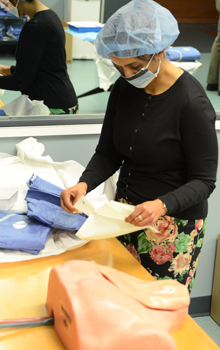| NYC Resources | 311 | Office of the Mayor |
|
|
Important notice on data breaches affecting some HHC patients |
To Prevent Infections, Practice With A Mannequin Simulated patients with plastic tubes for arteries help HHC providers master catheter insertion to prevent one of the most common hospital acquired infections.
On a cold but sunny early spring morning, latex rubber neck and torso mannequins with tubes for arteries that “bleed” like people were carefully set on mock operating tables. Five health care providers from across HHC suited up in gowns, caps, surgical masks and gloves and reached for the ultrasound machines to locate the precise spot for the intended procedure. They were each guided by master instructors, carefully swabbed with antiseptic the site on the “patient’s” neck and began to insert the catheter into the fake vein. In seconds, they would know if they had done the procedure successfully. “If the fluid runs red, which means the fake artery was punctured, they just have to take a deep breath and keep practicing. That’s the beauty of simulation training,” said Kevin Pohlman, a medical simulation specialist at the HHC Institute for Medical Simulation and Advanced Learning (IMSAL), the public healthcare system’s state-of-the-art training center in the Bronx. Pohlman developed this IMSAL “train the trainer” program to expand the team of instructors who will travel to HHC facilities to make the central line placement skills course more accessible to clinicians by offering it in their real work environment. Nearly 2,600 providers at HHC have taken the course since IMSAL opened in 2009 as part of an aggressive focus on patient safety and an innovative training curriculum to help physicians, nurses and other healthcare providers to master skills. The course is important because catheter-related bloodstream infections are a severe and costly problem for hospitals that can be prevented by following best practices, including a standard protocol for inserting central venous catheters - also known as central lines. The catheters deliver medication or nutrition into a large vein. A 2009 study found that as many as 80,000 central line infections occur annually in U.S. hospitals, accounting for 11% of hospital-acquired infections. Bacteria find their way down the tubes and into the bloodstream, leading to serious complications and longer intensive care stays. Federal regulators track such infections, and now penalize hospitals financially for them. But other studies have shown that taking steps to prevent central line infections, such as practicing proper hand hygiene, using sterile catheters, cleaning the insertion site and changing dressings often, can help prevent the infections and improve patient safety. A master instructor supervised the five participants at the IMSAL train-the-trainer course as Dr. Usha Venugopal, a hospitalist from Lincoln Medical and Mental Health Center, practiced inserting a line in a mannequin’s neck. “The instructors make you feel quite at ease,” she said. Katie Walker, RN, IMSAL Director, explained that “HHC providers learn the method of central line insertion using best evidence principles. And every HHC clinician learns the same procedure, which means that there is universal strategy across the corporation. This approach helps reduce errors.” The training and HHC’s standardized approach to reducing infections is working. Central line-associated bloodstream infections across all HHC adult intensive care units (ICUs) have dropped dramatically -- by 79 percent – since 2005. And a number of HHC hospitals, including Coney Island, Harlem and Jacobi, were able to achieve zero central line infections in some of their ICUs for two years in a row. Before the high-tech training devices used at IMSAL were invented, providers had to practice in the classroom and on cadavers, and acquire experience on real patients. But HHC’s state-of-the-art simulation center helps providers practice so that they, in turn, can go back to their hospitals and train others. “For the student it is great because you learn in a non-pressured environment,” said John Degliuomini, M.D., deputy chief of surgery at Metropolitan Hospital Center, who was being trained to become an instructor. “The only difference from what you do at the hospital is that you do it on a simulator, on a mannequin. Instructors observe you and walk you through it. You are in a safe place and you don’t have to be perfect.” “Simulation is becoming a major adjunct to healthcare education. Simulators support, not replace, traditional teaching and training methods,” said Pohlman, a paramedic who is one of just 300 certified health-care simulation educators in the world. “Simulation is a tool as much as a blackboard, but it allows a degree of realism and that is why it is so valuable.”
| ||||||
HHC 2014 Stats
- Staffed Beds: 6,684
- Clinic Visits: 4,472,960
- ER Visits: 1,179,436
- Discharges: 205,791
- Births: 18,564
| Copyright 2015 The City of New York | Contact Us | Privacy Policy | Terms of Use |


